Sociology Course Assignment: In-depth Analysis of Weekly Readings
VerifiedAdded on 2023/06/14
|8
|1838
|217
Homework Assignment
AI Summary
This sociology assignment provides a detailed analysis of several weekly readings. It explores Surette's concept of "predator crime" and its impact on public perception, linking it to symbolic interactionism. The assignment further examines Bourgois and Schonberg's ethnographic study of homeless heroin addicts, focusing on the historical and social contexts of their situation. It delves into Bentham's concept of panopticism and its modern applications in surveillance. Furthermore, the assignment analyzes Rosenhan's study on sanity in insane places and McCausland & Vivian's research on crime rates in Aboriginal communities, applying social disorganization theory. The work uses provided readings to answer specific questions, demonstrating an understanding of sociological concepts and theories.
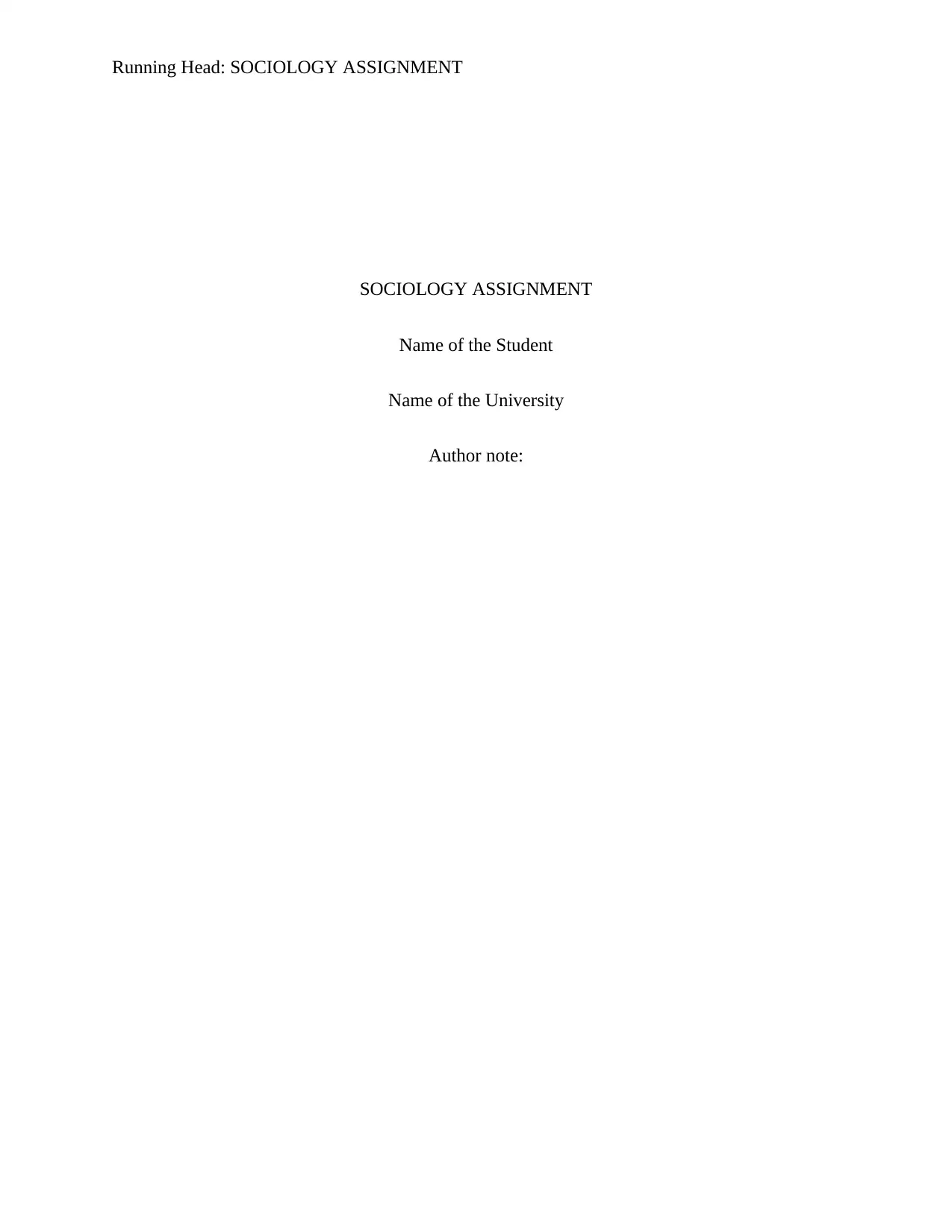
Running Head: SOCIOLOGY ASSIGNMENT
SOCIOLOGY ASSIGNMENT
Name of the Student
Name of the University
Author note:
SOCIOLOGY ASSIGNMENT
Name of the Student
Name of the University
Author note:
Paraphrase This Document
Need a fresh take? Get an instant paraphrase of this document with our AI Paraphraser
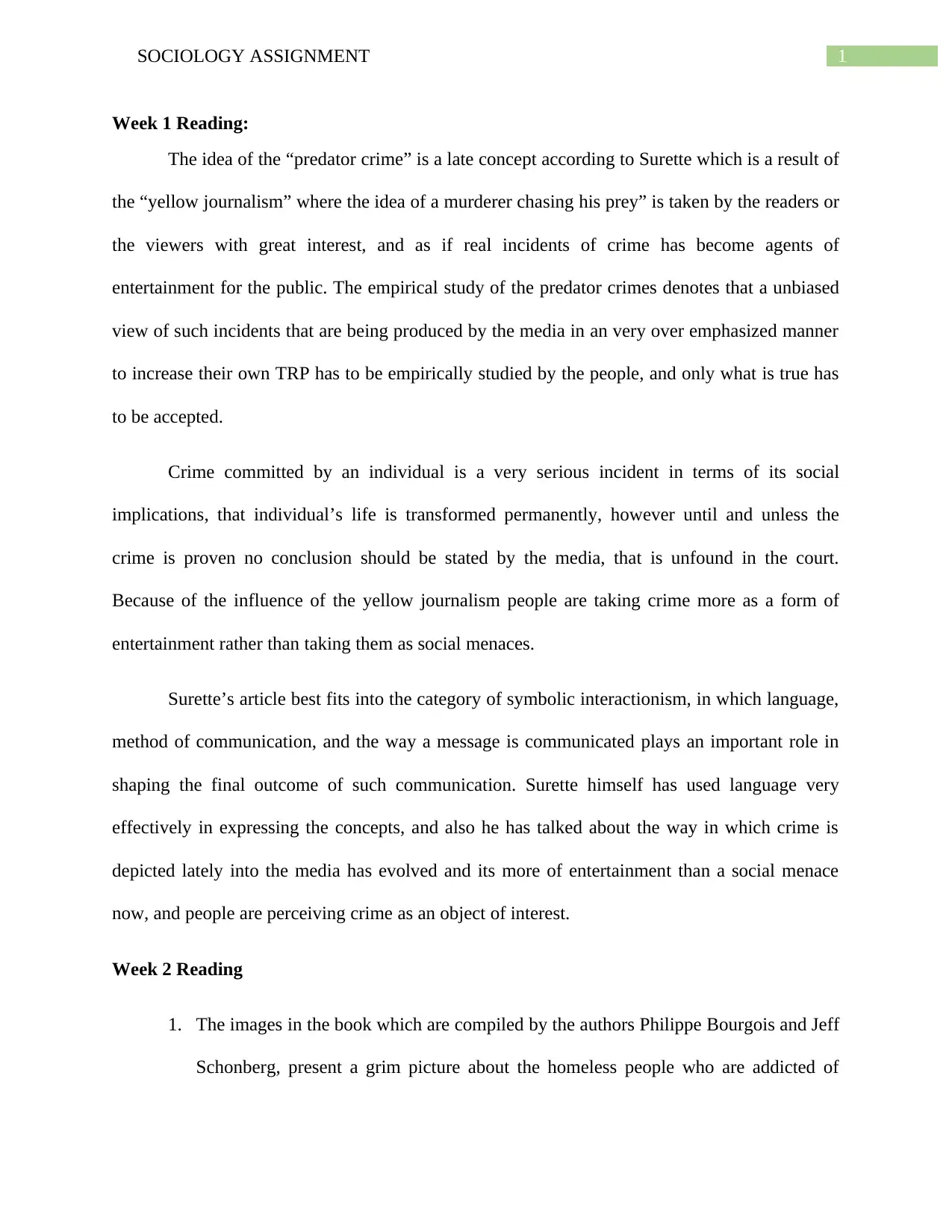
1SOCIOLOGY ASSIGNMENT
Week 1 Reading:
The idea of the “predator crime” is a late concept according to Surette which is a result of
the “yellow journalism” where the idea of a murderer chasing his prey” is taken by the readers or
the viewers with great interest, and as if real incidents of crime has become agents of
entertainment for the public. The empirical study of the predator crimes denotes that a unbiased
view of such incidents that are being produced by the media in an very over emphasized manner
to increase their own TRP has to be empirically studied by the people, and only what is true has
to be accepted.
Crime committed by an individual is a very serious incident in terms of its social
implications, that individual’s life is transformed permanently, however until and unless the
crime is proven no conclusion should be stated by the media, that is unfound in the court.
Because of the influence of the yellow journalism people are taking crime more as a form of
entertainment rather than taking them as social menaces.
Surette’s article best fits into the category of symbolic interactionism, in which language,
method of communication, and the way a message is communicated plays an important role in
shaping the final outcome of such communication. Surette himself has used language very
effectively in expressing the concepts, and also he has talked about the way in which crime is
depicted lately into the media has evolved and its more of entertainment than a social menace
now, and people are perceiving crime as an object of interest.
Week 2 Reading
1. The images in the book which are compiled by the authors Philippe Bourgois and Jeff
Schonberg, present a grim picture about the homeless people who are addicted of
Week 1 Reading:
The idea of the “predator crime” is a late concept according to Surette which is a result of
the “yellow journalism” where the idea of a murderer chasing his prey” is taken by the readers or
the viewers with great interest, and as if real incidents of crime has become agents of
entertainment for the public. The empirical study of the predator crimes denotes that a unbiased
view of such incidents that are being produced by the media in an very over emphasized manner
to increase their own TRP has to be empirically studied by the people, and only what is true has
to be accepted.
Crime committed by an individual is a very serious incident in terms of its social
implications, that individual’s life is transformed permanently, however until and unless the
crime is proven no conclusion should be stated by the media, that is unfound in the court.
Because of the influence of the yellow journalism people are taking crime more as a form of
entertainment rather than taking them as social menaces.
Surette’s article best fits into the category of symbolic interactionism, in which language,
method of communication, and the way a message is communicated plays an important role in
shaping the final outcome of such communication. Surette himself has used language very
effectively in expressing the concepts, and also he has talked about the way in which crime is
depicted lately into the media has evolved and its more of entertainment than a social menace
now, and people are perceiving crime as an object of interest.
Week 2 Reading
1. The images in the book which are compiled by the authors Philippe Bourgois and Jeff
Schonberg, present a grim picture about the homeless people who are addicted of
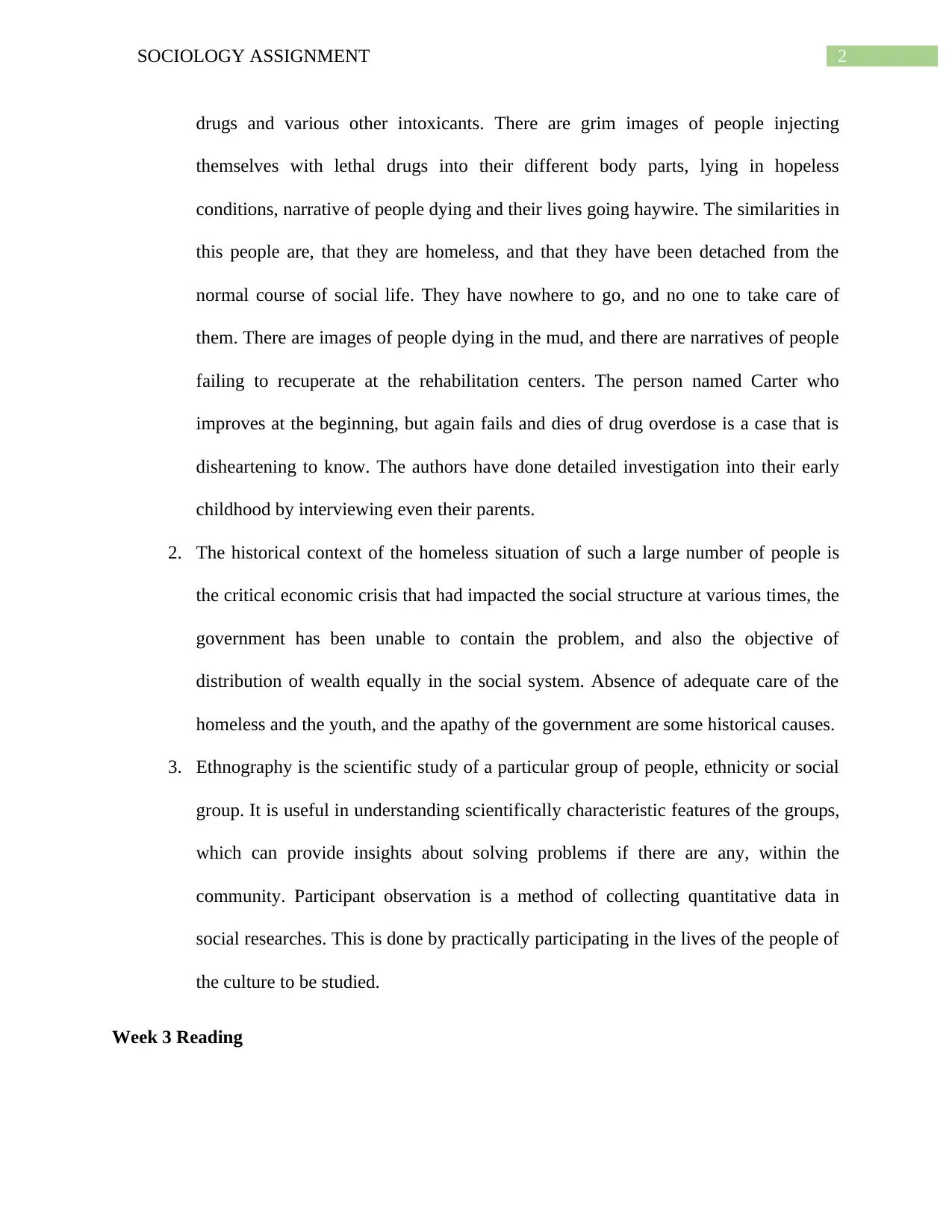
2SOCIOLOGY ASSIGNMENT
drugs and various other intoxicants. There are grim images of people injecting
themselves with lethal drugs into their different body parts, lying in hopeless
conditions, narrative of people dying and their lives going haywire. The similarities in
this people are, that they are homeless, and that they have been detached from the
normal course of social life. They have nowhere to go, and no one to take care of
them. There are images of people dying in the mud, and there are narratives of people
failing to recuperate at the rehabilitation centers. The person named Carter who
improves at the beginning, but again fails and dies of drug overdose is a case that is
disheartening to know. The authors have done detailed investigation into their early
childhood by interviewing even their parents.
2. The historical context of the homeless situation of such a large number of people is
the critical economic crisis that had impacted the social structure at various times, the
government has been unable to contain the problem, and also the objective of
distribution of wealth equally in the social system. Absence of adequate care of the
homeless and the youth, and the apathy of the government are some historical causes.
3. Ethnography is the scientific study of a particular group of people, ethnicity or social
group. It is useful in understanding scientifically characteristic features of the groups,
which can provide insights about solving problems if there are any, within the
community. Participant observation is a method of collecting quantitative data in
social researches. This is done by practically participating in the lives of the people of
the culture to be studied.
Week 3 Reading
drugs and various other intoxicants. There are grim images of people injecting
themselves with lethal drugs into their different body parts, lying in hopeless
conditions, narrative of people dying and their lives going haywire. The similarities in
this people are, that they are homeless, and that they have been detached from the
normal course of social life. They have nowhere to go, and no one to take care of
them. There are images of people dying in the mud, and there are narratives of people
failing to recuperate at the rehabilitation centers. The person named Carter who
improves at the beginning, but again fails and dies of drug overdose is a case that is
disheartening to know. The authors have done detailed investigation into their early
childhood by interviewing even their parents.
2. The historical context of the homeless situation of such a large number of people is
the critical economic crisis that had impacted the social structure at various times, the
government has been unable to contain the problem, and also the objective of
distribution of wealth equally in the social system. Absence of adequate care of the
homeless and the youth, and the apathy of the government are some historical causes.
3. Ethnography is the scientific study of a particular group of people, ethnicity or social
group. It is useful in understanding scientifically characteristic features of the groups,
which can provide insights about solving problems if there are any, within the
community. Participant observation is a method of collecting quantitative data in
social researches. This is done by practically participating in the lives of the people of
the culture to be studied.
Week 3 Reading
⊘ This is a preview!⊘
Do you want full access?
Subscribe today to unlock all pages.

Trusted by 1+ million students worldwide

3SOCIOLOGY ASSIGNMENT
1. Panopticism is the idea that originally originated from Bentham that an individual in
prison will be under all time surveillance by the guards in a manner that all their activities
will be carefully seen and any activities which will go against the rules of the prison will
be duly corrected by correctional measures initiated by the prison authority. The structure
was designed in a way that the jails will be round in shape and there will be rooms for
surveillance around the area wherte3 the guards will be sitting and observing the inmates
but they themselves will be out of the sight of the inmates. The term is now used to
indicate the situations where the individuals are put into 24-hour surveillance.
2. In the organizations today and everywhere in the society there is use of camera and
CCTVs that are used for 24 hours surveillance on the people who are related to the
organizations, for example if it is a workplace then the employees are put under
surveillance all the time, therefore the sense that the authorities are always keeping an
eye on them is there in the mind of the employees. They automatically tend to follow the
rules, without even any person trying to impose the rules on them. The presence of the
CCTV on the employees all the time gives the sense of surveillance, and the employees
are all the time on their toes to follow norms and perform their responsibilities in the best
way possible.
3. The present times are times of extreme monitoring and surveillance from all the social
agents. The last time I personally felt that there was more than required surveillance done
on me was the time I went to a particular mall, and in that mall in a book store, where I
felt that apart from the CCTV the guards are being over responsible and looking at each
and every move of the customers and into their hands, to make sure that any book or any
other product is not shoplifted.
1. Panopticism is the idea that originally originated from Bentham that an individual in
prison will be under all time surveillance by the guards in a manner that all their activities
will be carefully seen and any activities which will go against the rules of the prison will
be duly corrected by correctional measures initiated by the prison authority. The structure
was designed in a way that the jails will be round in shape and there will be rooms for
surveillance around the area wherte3 the guards will be sitting and observing the inmates
but they themselves will be out of the sight of the inmates. The term is now used to
indicate the situations where the individuals are put into 24-hour surveillance.
2. In the organizations today and everywhere in the society there is use of camera and
CCTVs that are used for 24 hours surveillance on the people who are related to the
organizations, for example if it is a workplace then the employees are put under
surveillance all the time, therefore the sense that the authorities are always keeping an
eye on them is there in the mind of the employees. They automatically tend to follow the
rules, without even any person trying to impose the rules on them. The presence of the
CCTV on the employees all the time gives the sense of surveillance, and the employees
are all the time on their toes to follow norms and perform their responsibilities in the best
way possible.
3. The present times are times of extreme monitoring and surveillance from all the social
agents. The last time I personally felt that there was more than required surveillance done
on me was the time I went to a particular mall, and in that mall in a book store, where I
felt that apart from the CCTV the guards are being over responsible and looking at each
and every move of the customers and into their hands, to make sure that any book or any
other product is not shoplifted.
Paraphrase This Document
Need a fresh take? Get an instant paraphrase of this document with our AI Paraphraser
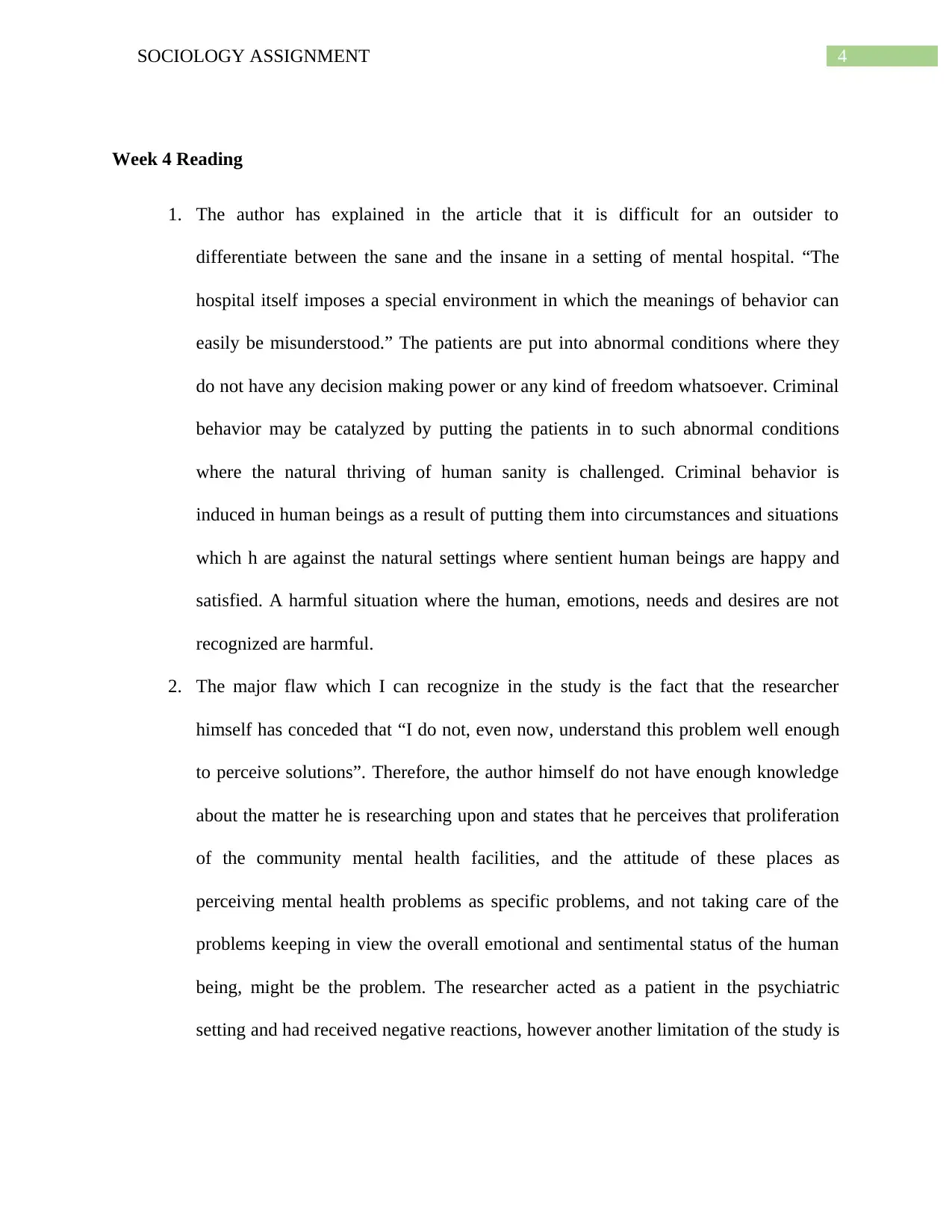
4SOCIOLOGY ASSIGNMENT
Week 4 Reading
1. The author has explained in the article that it is difficult for an outsider to
differentiate between the sane and the insane in a setting of mental hospital. “The
hospital itself imposes a special environment in which the meanings of behavior can
easily be misunderstood.” The patients are put into abnormal conditions where they
do not have any decision making power or any kind of freedom whatsoever. Criminal
behavior may be catalyzed by putting the patients in to such abnormal conditions
where the natural thriving of human sanity is challenged. Criminal behavior is
induced in human beings as a result of putting them into circumstances and situations
which h are against the natural settings where sentient human beings are happy and
satisfied. A harmful situation where the human, emotions, needs and desires are not
recognized are harmful.
2. The major flaw which I can recognize in the study is the fact that the researcher
himself has conceded that “I do not, even now, understand this problem well enough
to perceive solutions”. Therefore, the author himself do not have enough knowledge
about the matter he is researching upon and states that he perceives that proliferation
of the community mental health facilities, and the attitude of these places as
perceiving mental health problems as specific problems, and not taking care of the
problems keeping in view the overall emotional and sentimental status of the human
being, might be the problem. The researcher acted as a patient in the psychiatric
setting and had received negative reactions, however another limitation of the study is
Week 4 Reading
1. The author has explained in the article that it is difficult for an outsider to
differentiate between the sane and the insane in a setting of mental hospital. “The
hospital itself imposes a special environment in which the meanings of behavior can
easily be misunderstood.” The patients are put into abnormal conditions where they
do not have any decision making power or any kind of freedom whatsoever. Criminal
behavior may be catalyzed by putting the patients in to such abnormal conditions
where the natural thriving of human sanity is challenged. Criminal behavior is
induced in human beings as a result of putting them into circumstances and situations
which h are against the natural settings where sentient human beings are happy and
satisfied. A harmful situation where the human, emotions, needs and desires are not
recognized are harmful.
2. The major flaw which I can recognize in the study is the fact that the researcher
himself has conceded that “I do not, even now, understand this problem well enough
to perceive solutions”. Therefore, the author himself do not have enough knowledge
about the matter he is researching upon and states that he perceives that proliferation
of the community mental health facilities, and the attitude of these places as
perceiving mental health problems as specific problems, and not taking care of the
problems keeping in view the overall emotional and sentimental status of the human
being, might be the problem. The researcher acted as a patient in the psychiatric
setting and had received negative reactions, however another limitation of the study is
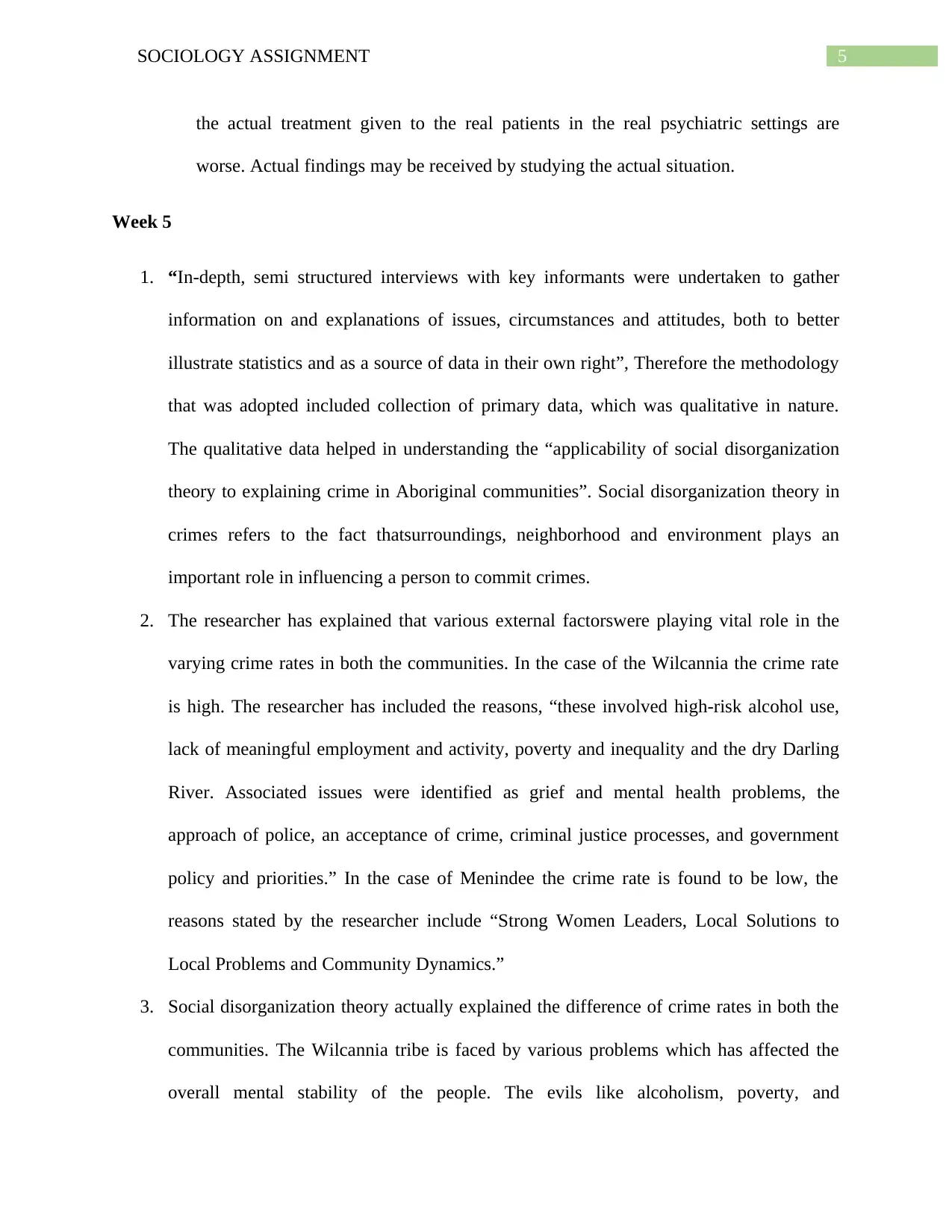
5SOCIOLOGY ASSIGNMENT
the actual treatment given to the real patients in the real psychiatric settings are
worse. Actual findings may be received by studying the actual situation.
Week 5
1. “In-depth, semi structured interviews with key informants were undertaken to gather
information on and explanations of issues, circumstances and attitudes, both to better
illustrate statistics and as a source of data in their own right”, Therefore the methodology
that was adopted included collection of primary data, which was qualitative in nature.
The qualitative data helped in understanding the “applicability of social disorganization
theory to explaining crime in Aboriginal communities”. Social disorganization theory in
crimes refers to the fact thatsurroundings, neighborhood and environment plays an
important role in influencing a person to commit crimes.
2. The researcher has explained that various external factorswere playing vital role in the
varying crime rates in both the communities. In the case of the Wilcannia the crime rate
is high. The researcher has included the reasons, “these involved high-risk alcohol use,
lack of meaningful employment and activity, poverty and inequality and the dry Darling
River. Associated issues were identified as grief and mental health problems, the
approach of police, an acceptance of crime, criminal justice processes, and government
policy and priorities.” In the case of Menindee the crime rate is found to be low, the
reasons stated by the researcher include “Strong Women Leaders, Local Solutions to
Local Problems and Community Dynamics.”
3. Social disorganization theory actually explained the difference of crime rates in both the
communities. The Wilcannia tribe is faced by various problems which has affected the
overall mental stability of the people. The evils like alcoholism, poverty, and
the actual treatment given to the real patients in the real psychiatric settings are
worse. Actual findings may be received by studying the actual situation.
Week 5
1. “In-depth, semi structured interviews with key informants were undertaken to gather
information on and explanations of issues, circumstances and attitudes, both to better
illustrate statistics and as a source of data in their own right”, Therefore the methodology
that was adopted included collection of primary data, which was qualitative in nature.
The qualitative data helped in understanding the “applicability of social disorganization
theory to explaining crime in Aboriginal communities”. Social disorganization theory in
crimes refers to the fact thatsurroundings, neighborhood and environment plays an
important role in influencing a person to commit crimes.
2. The researcher has explained that various external factorswere playing vital role in the
varying crime rates in both the communities. In the case of the Wilcannia the crime rate
is high. The researcher has included the reasons, “these involved high-risk alcohol use,
lack of meaningful employment and activity, poverty and inequality and the dry Darling
River. Associated issues were identified as grief and mental health problems, the
approach of police, an acceptance of crime, criminal justice processes, and government
policy and priorities.” In the case of Menindee the crime rate is found to be low, the
reasons stated by the researcher include “Strong Women Leaders, Local Solutions to
Local Problems and Community Dynamics.”
3. Social disorganization theory actually explained the difference of crime rates in both the
communities. The Wilcannia tribe is faced by various problems which has affected the
overall mental stability of the people. The evils like alcoholism, poverty, and
⊘ This is a preview!⊘
Do you want full access?
Subscribe today to unlock all pages.

Trusted by 1+ million students worldwide
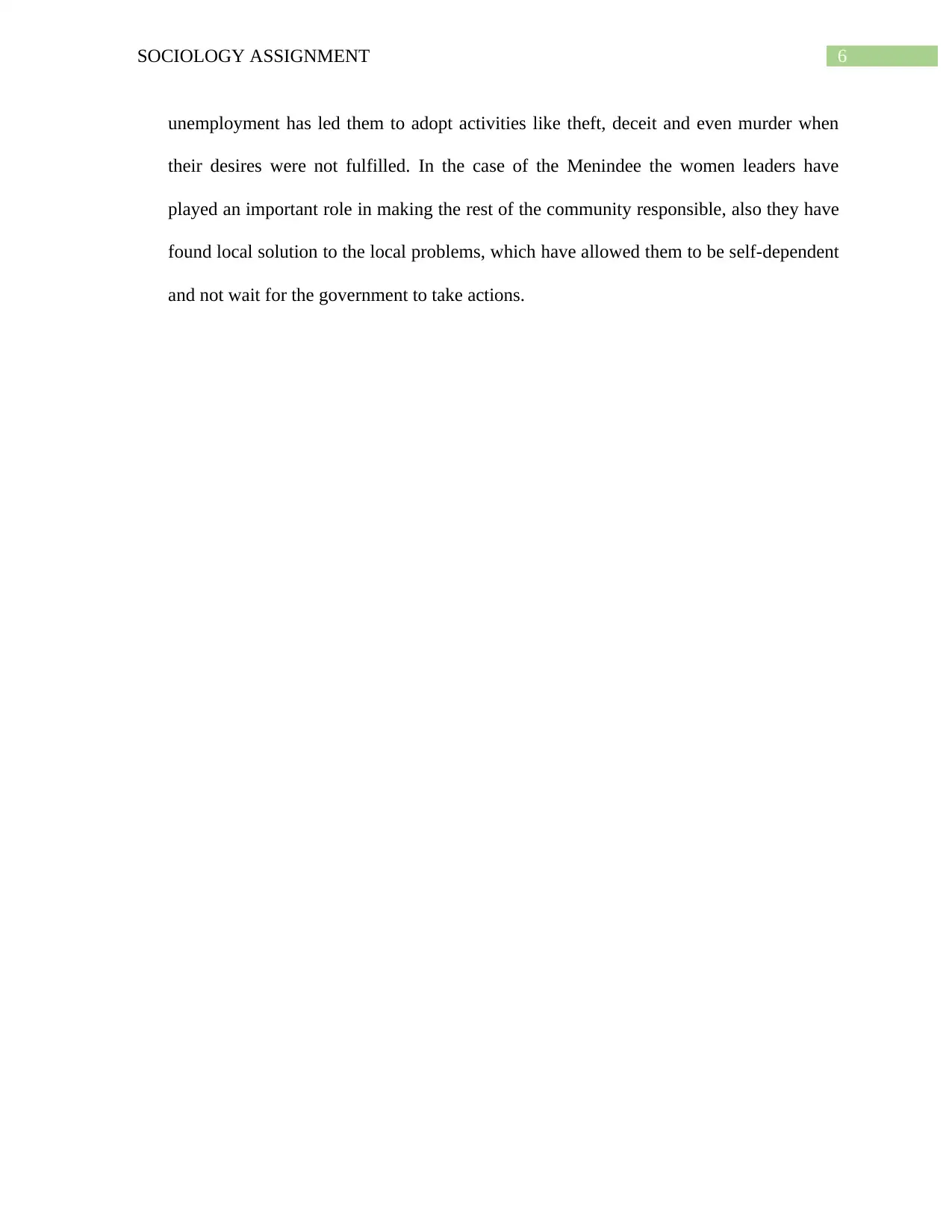
6SOCIOLOGY ASSIGNMENT
unemployment has led them to adopt activities like theft, deceit and even murder when
their desires were not fulfilled. In the case of the Menindee the women leaders have
played an important role in making the rest of the community responsible, also they have
found local solution to the local problems, which have allowed them to be self-dependent
and not wait for the government to take actions.
unemployment has led them to adopt activities like theft, deceit and even murder when
their desires were not fulfilled. In the case of the Menindee the women leaders have
played an important role in making the rest of the community responsible, also they have
found local solution to the local problems, which have allowed them to be self-dependent
and not wait for the government to take actions.
Paraphrase This Document
Need a fresh take? Get an instant paraphrase of this document with our AI Paraphraser
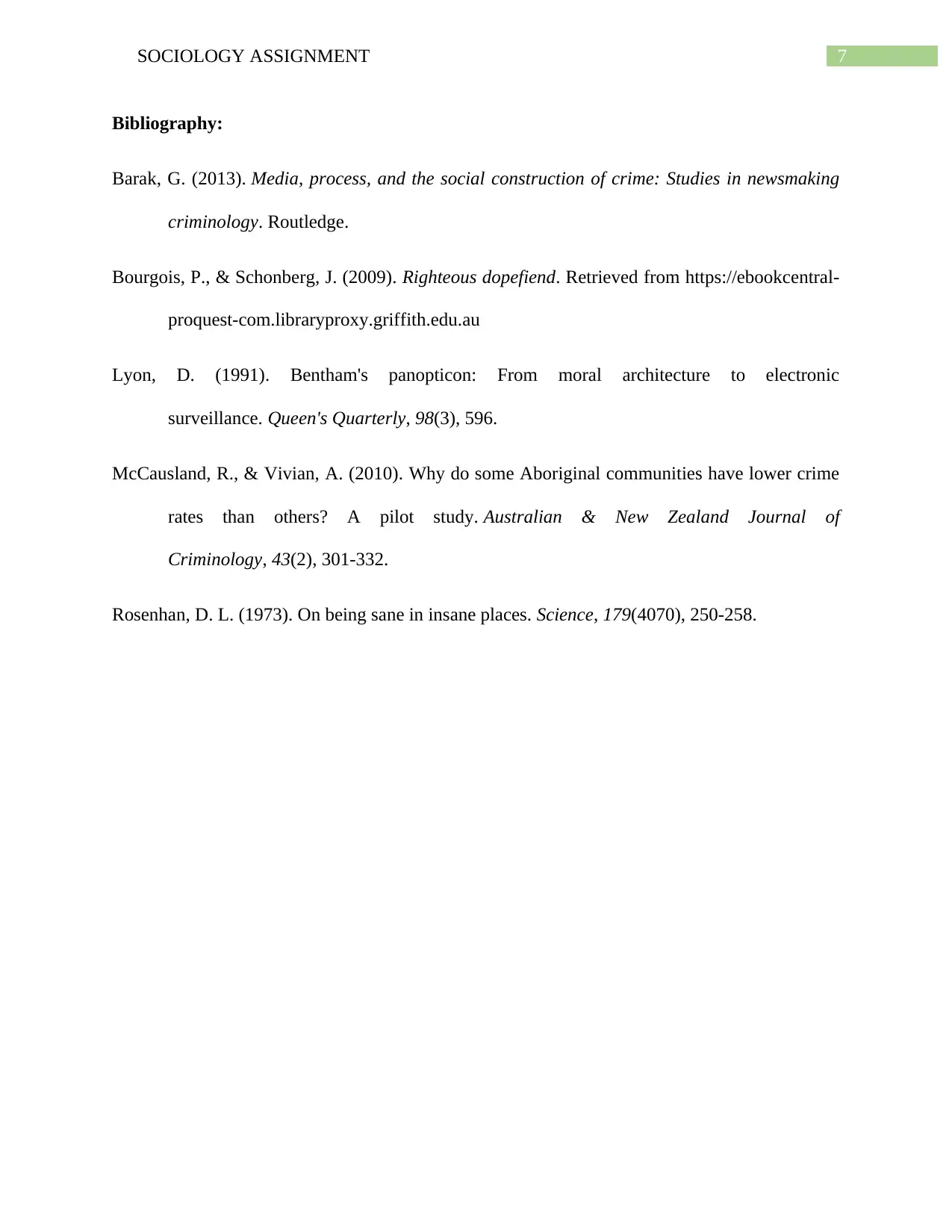
7SOCIOLOGY ASSIGNMENT
Bibliography:
Barak, G. (2013). Media, process, and the social construction of crime: Studies in newsmaking
criminology. Routledge.
Bourgois, P., & Schonberg, J. (2009). Righteous dopefiend. Retrieved from https://ebookcentral-
proquest-com.libraryproxy.griffith.edu.au
Lyon, D. (1991). Bentham's panopticon: From moral architecture to electronic
surveillance. Queen's Quarterly, 98(3), 596.
McCausland, R., & Vivian, A. (2010). Why do some Aboriginal communities have lower crime
rates than others? A pilot study. Australian & New Zealand Journal of
Criminology, 43(2), 301-332.
Rosenhan, D. L. (1973). On being sane in insane places. Science, 179(4070), 250-258.
Bibliography:
Barak, G. (2013). Media, process, and the social construction of crime: Studies in newsmaking
criminology. Routledge.
Bourgois, P., & Schonberg, J. (2009). Righteous dopefiend. Retrieved from https://ebookcentral-
proquest-com.libraryproxy.griffith.edu.au
Lyon, D. (1991). Bentham's panopticon: From moral architecture to electronic
surveillance. Queen's Quarterly, 98(3), 596.
McCausland, R., & Vivian, A. (2010). Why do some Aboriginal communities have lower crime
rates than others? A pilot study. Australian & New Zealand Journal of
Criminology, 43(2), 301-332.
Rosenhan, D. L. (1973). On being sane in insane places. Science, 179(4070), 250-258.
1 out of 8
Your All-in-One AI-Powered Toolkit for Academic Success.
+13062052269
info@desklib.com
Available 24*7 on WhatsApp / Email
![[object Object]](/_next/static/media/star-bottom.7253800d.svg)
Unlock your academic potential
Copyright © 2020–2025 A2Z Services. All Rights Reserved. Developed and managed by ZUCOL.
